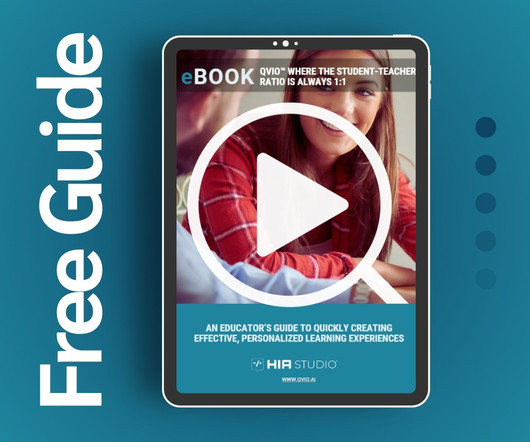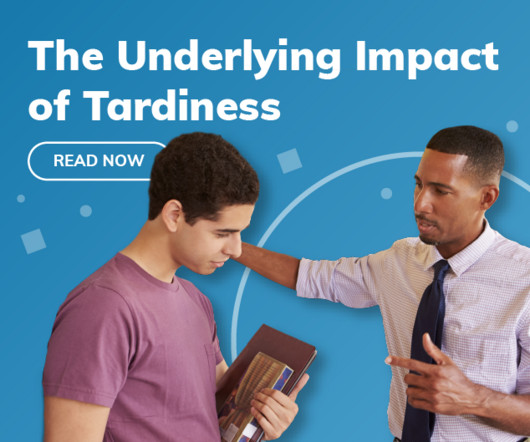4 Guidelines for Early Learners Using Technology
EdTech Magazine
NOVEMBER 8, 2016
By Meghan Bogardus Cortez These best practices from the Department of Education will help educators seamlessly integrate tech in the classroom.

EdTech Magazine
NOVEMBER 8, 2016
By Meghan Bogardus Cortez These best practices from the Department of Education will help educators seamlessly integrate tech in the classroom.

The CoolCatTeacher
NOVEMBER 9, 2016
Powerful Learning First, Technology Second From the Cool Cat Teacher Blog by Vicki Davis Follow @coolcatteacher on Twitter. Powerful learning first technology second. What does this mean in the classroom? Well, have you heard the school that bragged that “we have all new, shiny.” And in the blank insert Chromebook, iPads, BYOD, or laptops.
This site is protected by reCAPTCHA and the Google Privacy Policy and Terms of Service apply.

Catlin Tucker
NOVEMBER 8, 2016
Who does the following tasks in your classroom: Plans daily lessons. Teaches or facilitates each lesson. Designs projects. Troubleshoots technology hiccups. Assesses student work. Communicates with parents about student progress. If the answer to most of these questions is you, the teacher, then you’ve already realized you are doing the lion’s share of the work in your classroom.

Digital Promise
NOVEMBER 10, 2016
Why Students Develop an Aversion to Mathematics — and How Teachers Can Help Change Their Minds. This article originally appeared on Usable Knowledge from the Harvard Graduate School of Education. We’ve all seen it happen to a child confronting long division, or a teenager grappling with geometry. We’ve even done it ourselves. The frustrated pencil drop, the defeated shoulder slump, and finally, the resigned proclamation: “I just can’t get this.

Generative AI holds tremendous promise for all stakeholders in higher education. But guardrails are needed. Strong governance that empower instructors are at the core of a responsible approach to using generative AI in academia.

A Principal's Reflections
NOVEMBER 6, 2016
One of my fondest memories of school was my science teacher, Mr. South. Having attended a K-8 consolidated school in rural NJ, we knew who all the teachers were. However, Mr. South stood out. I remember an elementary student seeing paper flyers with a caricature of Mr. South wearing one of his famous flannel shirts. As the years passed, he transitioned from flannel to a dress shirt, tie, and jeans.

Ask a Tech Teacher
NOVEMBER 17, 2016
Coding–that geeky subject that confounds students and frightens teachers. Yet, kids who can code are better at logical thinking and problem solving, more independent and self-assured, and more likely to find a job when they graduate. In fact, according to Computer Science Education , by 2020 , there will be 1.4 million coding jobs and only 400,000 applicants.
EdTech Update brings together the best content for education technology professionals from the widest variety of industry thought leaders.

The CoolCatTeacher
NOVEMBER 8, 2016
How Sedentary Education Hurts Kids From the Cool Cat Teacher Blog by Vicki Davis Follow @coolcatteacher on Twitter. Many kids may not have ADD or ADHD but have those symptoms because their school is requiring them to sit for such long periods of time, according to Dr. Brad Johnson. Today’s guest shares the latest research about physical activity and school performance.

Catlin Tucker
NOVEMBER 29, 2016
I’ve been in love with Shakespeare since college. However, the very thing I love about Shakespeare’s plays–the language–is the exact thing that alienates so many students. The language is foreign and the humor goes over their heads. I’ve tried a variety of techniques to hook my students from having them complete soundtrack projects for the plays to performing the scenes in class.

Neo LMS
NOVEMBER 15, 2016
This piece originally appeared on edtechdigest.com. The first pop-up children’s book I ever touched was Little Red Riding Hood. I was a high school senior and I had thought I was over the fairy tales phase age. Yet I was super impressed with the pop-up Little Red Riding Hood. The story was the same. Except that it wasn’t. The pop-ups made it different; they added another dimension to it.

EdTech4Beginners
NOVEMBER 9, 2016
QR codes or quick response codes are brilliant to use in the classroom. They are basically machine-readable labels that contain information about the item to which attached. You can create them easily on the website QR Stuff. Simply choose what you want to link to (text, websites, images, videos etc.) and then select a colour and the QR code is instantly generated; ready to be shared, downloaded or printed.

Advertisement
Schools face increasing challenges as technology becomes integral to education. Efficient device management is essential for maximizing technology use and safeguarding investments. Our article discusses the importance of tracking devices, outlines current challenges, and suggests modern solutions that go beyond traditional methods like Excel. Learn how advanced tracking systems can streamline operations, improve maintenance, and offer real-time updates for better resource allocation.

Ed Tech from the Ground Up
NOVEMBER 29, 2016
For all its controversy, the SAT better correlates more strongly with high school students' declining reading abilities than does GPA. The post A Positive Role for Ed-Tech Products in the Murky World of SAT Scores appeared first on Market Brief.

EdTech Magazine
NOVEMBER 29, 2016
By Meghan Bogardus Cortez Make sure your district is geared up for what’s next in education by collaborating to build a strong infrastructure.

The CoolCatTeacher
NOVEMBER 10, 2016
An Epic Guide to Wearables From the Cool Cat Teacher Blog by Vicki Davis Follow @coolcatteacher on Twitter. Wearables are in education. Without us noticing, many of them walked through the front door. Since wearables are here, let’s understand and use them today. This post is sponsored by Samsung. All thoughts and opinions are my own. As an illustration, some wearable devices can count: Calories.

Catlin Tucker
NOVEMBER 17, 2016
Look familiar? For years I’ve watched students lug cumbersome binders to each class–dutifully take notes and collecting large quantities of paper. I’ve often wondered how useful these binders are and how often students sift through their papers to review information. This year, students in N.E.W. School traded in their traditional notebooks for multimedia digital blogs using Blogger.

Advertisement
How can we actively engage learners 24/7, on their level and according to their interests, while respecting their learning styles? It’s not impossible. In this guide: Explore how to transform traditional, one-way videos into two-way interactive learning experiences Understand different types of artificial intelligence (AI), including - Generative vs.

Ask a Tech Teacher
NOVEMBER 15, 2016
Coding–that mystical geeky subject that confounds students and teachers alike. Confess, when you think of coding, you see: …when you should see. December 5-11, Computer Science Education will host the Hour Of Code–a one-hour introduction to coding, programming, and why students should love it. It’s designed to demystify “code” and show that anyone can learn the basics to be a maker, a creator, and an innovator.

Ditch That Textbook
NOVEMBER 10, 2016
If we want to use technology in the classroom, we can’t just do the same kind of learning we did before it. Technology should improve the learning. Kick the lesson up a notch. Otherwise, our technology isn’t any better than our paper and pencil lessons, right? If your students are studying anything that connects to [.].

Ed Tech from the Ground Up
NOVEMBER 2, 2016
The ed-tech startup journey is a continuum, and the relationships we've built along the way make our whole community stronger. The post Networking Plays a Crucial Role in Startup Progress and Beyond appeared first on Market Brief.

EdTech Magazine
NOVEMBER 30, 2016
By Wylie Wong A K–12 technology leader shares tips for deploying Microsoft’s long-awaited educational game.

Speaker: Andrew Cohen, Founder & CEO of Brainscape
The instructor’s PPT slides are brilliant. You’ve splurged on the expensive interactive courseware. Student engagement is stellar. So… why are half of your students still forgetting everything they learned in just a matter of weeks? It's likely a matter of cognitive science! With so much material to "teach" these days, we often forget to incorporate key proven principles into our curricula — namely active recall, metacognition, spaced repetition, and interleaving practice.

The CoolCatTeacher
NOVEMBER 22, 2016
Tips and Tricks I've Learned from Experience From the Cool Cat Teacher Blog by Vicki Davis Follow @coolcatteacher on Twitter. Online and face-to-face spaces blend to create a today’s classroom. Most schools have physical buildings. For purposes of this article, we’ll call these “the bricks.” Also, schools also have online spaces where students work and collaborate.

Digital Promise
NOVEMBER 15, 2016
Twenty English language learners, gathered at an East Boston community-based organization, are playing a storytelling game on their mobile phones. After beating the game and receiving a check mark for a successful mission, the players return to a virtual world where they, as their avatars, mingle with players in Florida. They chat by typing messages and arrange to play a word-guessing game together.

Ask a Tech Teacher
NOVEMBER 16, 2016
Here are ideas of apps and websites that teachers in my PLN used successfully in the past during Hour of Code: Kindergarten. Start kindergartners with problem solving. If they love Legos, they’ll love coding. BotLogic –great for Kindergarten and youngers. Code –learn to code, for students. How to train your robot –a lesson plan from Dr. Techniko. Kodable- -great for youngers–learn to code before you can read.

EdTech4Beginners
NOVEMBER 20, 2016
It is great to create quizzes and tests for your class, but why not flip this? Ask your students to make one themselves. Recently my class used the brilliant website Kahoot! to create maths word problems. Here is an example a pupil in my class made: When they were complete, we played the games that had been created: It was great because the students led the game themselves; it certainly engaged and empowered them!

Advertisement
Managing a K-12 campus with constant pressure to meet performance metrics is challenging. And tardiness can significantly limit a school from reaching these goals. Learn more about why chronic lateness matters, and key strategies to address the following impacts: Data errors caused by manual processes Low attendance and graduation rates that affect a school’s reputation Classroom disruption, which leads to poor academic performance High staff attrition and “The Teacher Exodus” Unmet LCAP goals t

Teacher Reboot Camp
NOVEMBER 25, 2016
“As we work to create light for others, we naturally light our own way.” – Mary Anne Radmacher. December is right around the corner and one way to celebrate the holidays with your students is by creating a digital calendar of activities. You can create an advent calendar full of cool web tool projects , a calendar of kind acts, a calendar to motivate students to keep learning during the break, a calendar introducing students to different traditions and cultures around the world

EdTech Magazine
NOVEMBER 21, 2016
By Meghan Bogardus Cortez Two education experts offer up best practices for utilizing mobile technology.

The CoolCatTeacher
NOVEMBER 29, 2016
Digital Citizenship Spotlight From the Cool Cat Teacher Blog by Vicki Davis Follow @coolcatteacher on Twitter. Most students use smartphones with unfiltered access to the Internet. Even worse, many students have no filter when they consider what they should share. Schools and parents need to get smart about how they talk to kids about smartphones. Listen to this show on: BAM Radio Network | iTunes .

A Principal's Reflections
NOVEMBER 27, 2016
There are many lessons we can learn from the business world and adapt in ways that align with education. Take the concept of branding. Since the advent of media organizations across the globe have worked tirelessly to build a positive brand presence that resonates with potential consumers. In short it represents a promise that is woven into a combination of words, design, colors, music, video, logo, service, etc.

Speaker: Chris Paxton McMillin, President of D3 Training Solutions
There are plenty of great authoring tools for developing eLearning, but the one you select could directly impact your course's outcomes. Depending upon your learners’ needs and your organization’s performance goals, you could be overlooking considerations that impact the both effectiveness of your courses and how long it takes to finish them. From general capabilities to specific workflow structures, some aspects are critical when it comes to learning objectives and deadlines.

Digital Promise
NOVEMBER 22, 2016
In November 2016, over 250 school district leaders, researchers, thought leaders, and other partners came to Baltimore, Maryland to learn from one of the nation’s most forward-thinking school districts, Baltimore County Public Schools (BCPS). This League of Innovative Schools meeting was focused on equity, and showcased how BCPS is making strides toward providing access and opportunity for all students.

Ed Tech from the Ground Up
NOVEMBER 18, 2016
Networking can be out of our comfort zone, but it's important to be open and to listen to what others are doing. You may find an unexpected connection. The post Chance Networking Expands an Ed-Tech Startup’s Horizons appeared first on Market Brief.

Ask a Tech Teacher
NOVEMBER 8, 2016
All teachers agree that digital citizenship is essential knowledge for students whether they’re going onto college or a career, yet when I ask who in their school teaches it, they always shrug. Someone, but not them… Ask a Tech Teacher contributor, Amy Williams, has four bottom line issues that any teacher can cover and as many as possible at each grade level should: Educators have always had the challenging task of teaching our children reading, writing and arithmetic, among many ot

EdTech Magazine
NOVEMBER 18, 2016
By Eric Patnoudes K–12 district leaders need to set goals, work across silos and provide PD and training.

This white paper examines and proposes revisions to the "Seven Principles for Good Practice in Undergraduate Education" introduced by Arthur Chickering and Zelda Gamson in 1987 for today's technology-driven world.
Let's personalize your content